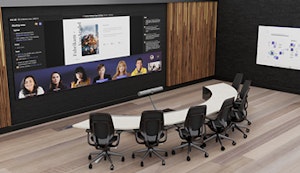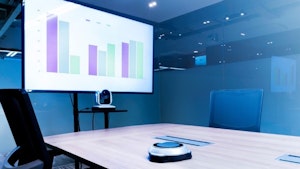Immersive meetings: a hybrid solution easier said than done?
Immersive experiences and user engagement are key priorities in the hybrid workplace, but what tools and technologies are available to make this a reality? And what happens in larger spaces?
Microsoft recently outlined its vision for the future of meeting rooms in the era of hybrid working, alongside its newly branded ‘Signature’ Teams Room solution. This cements some of its previous concepts and outlines an overall strategy for product release and development. Microsoft is now offering formal guidance for customers trying to deliver an optimal meeting room experience incorporating Microsoft’s enhanced meeting and collaboration tools such as Front Row and integration with whiteboard capture cameras.

To many, it looks like videoconferencing has gone full circle, with the proposed room solutions looking much like traditional telepresence systems. However, Microsoft is looking to push things forward to enable simple operation and prioritise engagement.
The two primary goals it has set are: a) everyone in the meeting feels included, represented, and productive, and b) connections feel natural and immersive. These goals stress inclusion and immersion, expanding on the previous goals of video conferencing and collaboration by making these elements a key focus.
The associated design principles then drive guidance of all elements of Signature Teams Room solutions including furniture, layout, technology, and physical elements such as floor and wall finishes and acoustic and lighting requirements.
Fundamental adjustment
While Microsoft has issued this guidance and given their vision and strategy visibility, it is notable that no other organisations has put out a similar statement to date. Rather than identifying a need to fundamentally adjust meeting spaces themselves to accommodate new ways of working, Cisco, Google and others are still maintaining an approach based around solutions to traditional meeting spaces, with additional features and enhancements.
This presents designers and end users with a bit of a conundrum. Microsoft is continuing to increase its market share of the Unified Communications (UC) market with Microsoft Teams, and with its integration with the rest of Microsoft’s software suite.
But does its increasingly dominant position mean that its approach should be considered applicable to all customers, or just those that use Microsoft-based solutions? Given the impact on room size, layout and usage, its Signature Teams Rooms and associated vision for the future of meeting rooms would require significant modifications to existing or proposed workplace strategy, meeting room quantities, layouts, and capacities – all needing significant investment.
Universally applicable?
Ultimately, the question is whether Microsoft’s vision is likely to become a reality in either the short or long term, and whether this is universally applicable or will remain the penchant for only certain organisations or use cases. Even Microsoft acknowledge this in their documentation. It states: ‘Not every organisation can prioritise [this way] for every meeting space, as it could reduce the number of meeting rooms they can have’.

Image: Courtesy of Microsoft
For any organisation, let alone one that doesn’t currently use Microsoft Teams as its UC platform of choice, designing entire offices based on a strategy of a single vendor is considerably risky. Historically, Microsoft hasn’t helped in this regard (I’m looking at you, O.G. Surface Hub). However, if companies choose to ignore Microsoft’s approach, there is also a risk that they will miss riding the next wave of hybrid working benefits and be left behind. Will other UC vendors end up on a similar path to Microsoft?
‘Solutions for really large rooms, including training rooms, and events spaces, remain undefined…’
It should be noted that the recently issued vision and strategy documents do not include fully scalable solutions. Microsoft (and others) have many solutions for small and huddle rooms, and now options for medium and larger rooms are available as well. However, solutions for really large rooms, including training rooms, boardrooms, client suites, divisible rooms and events spaces, remain undefined.
Microsoft guidance and best practice information is notably absent for such spaces, and in creating curated, locked-down solutions for smaller rooms, the company is limiting the ability to properly integrate its solutions into more complex spaces. It is therefore left to system designers to develop solutions based around multiple product sets that cannot be given formal Microsoft Teams certification.
The message from Microsoft is clear – it does not support the use of Microsoft Teams in spaces beyond its standard meeting room designs. Companies are therefore faced with another choice – limit their workplace to only include UC integration in meeting rooms up to a certain size; or deploy a bespoke solution in larger spaces.
Taking holistic view
As consultants, we are constantly engaged with clients looking to us to deliver technology solutions that meet their strategic goals. In a majority of cases, this includes one or more meeting and/or events spaces requiring UC integration that do not fall into any of Microsoft’s current standard meeting types. Through coordination with end users, architects and other designers, we take a holistic view to ensure that not only the technology but the spaces themselves are suitable.
Often, however, a client’s choice of UC platform is made without consideration to wider implications and we are left to develop solutions based on technology choices made in isolation of any spatial requirements for meeting or event spaces.
Whilst we are able to offer clients the benefit of our expertise for all meeting spaces, it is on these larger meeting and event spaces that we spend much of our time focusing as consultants, given the huge variance of spaces and their use cases. Our approach begins always by identifying requirements first and then looking how these can be met by both the technology and the layout.
Experience equity
A common request is to ensure experience equity, delivering an engaging meeting to both in-person and remote attendees. However, we are often now seeing a desire to prioritise remote attendees through solutions that are not only expensive, but quite possibly go beyond what is necessary. After all, whilst it may be technically possible to provide remote attendees with a framed head and shoulder camera shot of every local participant, this isn’t the experience of people in the room.
We take a pragmatic approach and guide our clients through both the art of the possible as well as the practical, ultimately aiming to deliver the most cost-effective solution that meets their requirements for quality and functionality.
‘Providing solutions that offer as good and consistent an experience as is possible…’
Consistency remains a challenge. Users can now quite easily have a consistent experience both locally and remote when using Microsoft Teams (and other platforms) in small to medium rooms. Enhanced experiences can now be provided almost out of the box. However, whilst Microsoft may begin releasing products that can be more easily integrated into complex or unique spaces, or start offering guidance for event space or divisible room, it is left to the designers, consultants and integrators to provide solutions that offer as good and consistent an experience as is possible.
Immersive experiences and user engagement are likely to continue to be priorities, although many variables remain, particularly when considering integration with multiple UC platforms. Ultimately, the sky’s the limit – it’s up to us to bring this back to earth.









